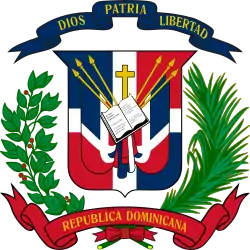Rafael Trujillo
Rafael Leónidas Trujillo Molina (/truːˈhiːjoʊ/ troo-HEE-yoh, Spanish: [rafaˈel leˈonidas tɾuˈxiɟ͡ʝo]; 24 October 1891 – 30 May 1961), nicknamed El Jefe (Spanish: [el ˈxefe], "The Chief" or "The Boss"), was a Dominican dictator who ruled the Dominican Republic from February 1930 until his assassination in May 1961.[2] He served as president from 1930 to 1938 and again from 1942 to 1952, ruling for the rest of the time as an unelected military strongman under figurehead presidents.[Note 1] His 31 years in power, to Dominicans known as the Trujillo Era (Spanish: El Trujillato), are considered one of the bloodiest eras ever in the Americas, as well as a time of a personality cult, when monuments to Trujillo were in abundance. Trujillo and his regime were responsible for many deaths, including between 5,000 and 67,000 Haitians in the infamous Parsley massacre.[3][Note 2][Note 3]
Rafael Trujillo | |
|---|---|
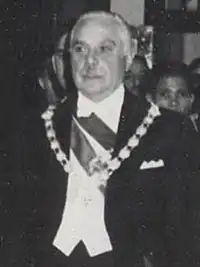 Trujillo during an August 1952 visit to the Dominican Republic by President Anastasio Somoza Garcia of Nicaragua | |
| President of the Dominican Republic | |
| In office 16 August 1930 – 16 August 1938 | |
| Vice President | Rafael Estrella Ureña (1930–1931) vacant (1932–1934) Jacinto Peynado (1934–1938) |
| Preceded by | Rafael Estrella Ureña (acting) |
| Succeeded by | Jacinto Peynado |
| In office 18 May 1942 – 16 August 1952 | |
| Vice President | None |
| Preceded by | Manuel de Jesús Troncoso de la Concha |
| Succeeded by | Héctor Trujillo |
| Personal details | |
| Born | Rafael Leónidas Trujillo Molina 24 October 1891 San Cristóbal, Dominican Republic |
| Died | 30 May 1961 (aged 69) Ciudad Trujillo, Dominican Republic |
| Cause of death | Assassination by gunshot |
| Resting place | Mingorrubio Cemetery, Madrid, Spain |
| Political party | Dominican Party |
| Spouse(s) | Aminta Ledesma y Pérez
(m. 1913; div. 1925)Bienvenida Ricardo y Martínez
(m. 1927; div. 1935)María de los Ángeles Martínez y Alba
(m. 1937; |
| Children | 8, including Ramfis and Angelita[1] |
| Profession |
|
Trujillo was worth 800 million dollars (5.3 billion dollars today).[6] During his long rule, the Trujillo government extended its policy of state terrorism beyond national borders. Notorious examples of Trujillo's reach abroad are the unsuccessful assassination attempt in Caracas against Venezuelan President Rómulo Betancourt (1960), the abduction and subsequent disappearance in New York City of the Spaniard Jesús Galíndez (1956), the murder of writer José Almoina in Mexico, also a Spaniard, and crimes committed against Cubans, Costa Ricans, Nicaraguans, and Puerto Ricans, as well as Americans.[7] On 30 May 1961, Trujillo was assassinated by conspirators sponsored by the Central Intelligence Agency (CIA). In the immediate aftermath, Trujillo's son Ramfis took temporary control of the country, and vowed to kill those involved in the death of his father. By 19 November 1961, Trujillo's relatives and cronies, like Joaquín Balaguer, who fled to New York City, were forced to leave the country, but not before killing the surviving members of the assassination plot.
The Trujillo era unfolded in a Hispanic Caribbean environment that was particularly fertile for dictatorial regimes.[Note 4] In the countries of the Caribbean Basin alone, his dictatorship was concurrent, in whole or in part, with those in Cuba, Nicaragua, Guatemala, El Salvador, Honduras, Venezuela, and Haiti. In retrospect, the Trujillo dictatorship has been characterized as more prominent and more brutal than those that rose and fell around it.[9] Trujillo remains a polarizing figure in the Dominican Republic, the sheer longevity of his rule makes a detached evaluation difficult. While his supporters credit him for bringing stability and prosperity to the country, others criticize his heavy-handed rule and disregard for civil rights and freedoms.
Early life
Rafael Leonidas Trujillo Molina was born on 24 October 1891 in San Cristóbal, Dominican Republic, into a lower-middle-class family.[10] His father was José Trujillo Valdez, the son of Silveria Valdez Méndez of colonial Dominican origin and José Trujillo Monagas, a Spanish sergeant who arrived in Santo Domingo as a member of the Spanish reinforcement troops during the annexation era. Trujillo's mother was Altagracia Julia Molina Chevalier, later known as Mama Julia, the daughter of Pedro Molina Peña, also of colonial Dominican origin, and the teacher Luisa Erciná Chevalier, whose parents were part of the remaining French descendants in Haiti: Trujillo's maternal great-grandfather, Justin Víctor Turenne Carrié Blaise, was of French descent, while his maternal great-grandmother, Eleonore Juliette Chevallier Moreau, was part of Haiti's mulatto class.[11][12] Trujillo was the third of eleven children;[10][Note 5] he also had an adopted brother, Luis Rafael "Nene" Trujillo (21 January 1935 – 14 August 2005), who was raised in the home of Trujillo Molina.[11]
In 1897, at the age of six, Trujillo was registered in the school of Juan Hilario Meriño. One year later, he transferred to the school of Broughton, where he became a pupil of Eugenio María de Hostos and remained there for the rest of his primary schooling. At the age of 16, Trujillo got a job as a telegraph operator, which he held for about three years. Shortly after Trujillo turned to crime: cattle stealing, check counterfeiting, and postal robbery. He spent several months in prison, which did not deter him, as he later formed a violent gang of robbers called the 42.[13][14]
| Ancestors of Rafael Trujillo | ||||||||||||||||||||||||||||||||||||||||||||||||||||||||||||||||||||||||||||||||||||||||||||||||||||||||||||||||||||||||||||||||||||||||||||||||||||||||||||||||||||||||||||||||||||||||||||||||||||||||||||||||||||||||||||||||||||||||||||||||||||||||||||||||||||||||||||||||||||||||||||||||||||||||||||||||||||||||||||||||||||||||||||||||||||||||||||||||||||||||||||||||||||||||||||||||||||||||||||||||||||||||||||||||||||||||||||||||||||||||||||||||||||||||||||||||||||||||||||||||||||||||||||||||||||||||||||||||||||||||||||||||||||||||||||||||||||||||||||||||||||||||||||||||
|---|---|---|---|---|---|---|---|---|---|---|---|---|---|---|---|---|---|---|---|---|---|---|---|---|---|---|---|---|---|---|---|---|---|---|---|---|---|---|---|---|---|---|---|---|---|---|---|---|---|---|---|---|---|---|---|---|---|---|---|---|---|---|---|---|---|---|---|---|---|---|---|---|---|---|---|---|---|---|---|---|---|---|---|---|---|---|---|---|---|---|---|---|---|---|---|---|---|---|---|---|---|---|---|---|---|---|---|---|---|---|---|---|---|---|---|---|---|---|---|---|---|---|---|---|---|---|---|---|---|---|---|---|---|---|---|---|---|---|---|---|---|---|---|---|---|---|---|---|---|---|---|---|---|---|---|---|---|---|---|---|---|---|---|---|---|---|---|---|---|---|---|---|---|---|---|---|---|---|---|---|---|---|---|---|---|---|---|---|---|---|---|---|---|---|---|---|---|---|---|---|---|---|---|---|---|---|---|---|---|---|---|---|---|---|---|---|---|---|---|---|---|---|---|---|---|---|---|---|---|---|---|---|---|---|---|---|---|---|---|---|---|---|---|---|---|---|---|---|---|---|---|---|---|---|---|---|---|---|---|---|---|---|---|---|---|---|---|---|---|---|---|---|---|---|---|---|---|---|---|---|---|---|---|---|---|---|---|---|---|---|---|---|---|---|---|---|---|---|---|---|---|---|---|---|---|---|---|---|---|---|---|---|---|---|---|---|---|---|---|---|---|---|---|---|---|---|---|---|---|---|---|---|---|---|---|---|---|---|---|---|---|---|---|---|---|---|---|---|---|---|---|---|---|---|---|---|---|---|---|---|---|---|---|---|---|---|---|---|---|---|---|---|---|---|---|---|---|---|---|---|---|---|---|---|---|---|---|---|---|---|---|---|---|---|---|---|---|---|---|---|---|---|---|---|---|---|---|---|---|---|---|---|---|---|---|---|---|---|---|---|---|---|---|---|---|---|---|---|---|---|---|---|---|---|---|---|---|---|---|---|---|---|---|---|---|---|---|---|---|---|---|---|---|---|---|---|---|---|---|---|---|---|---|---|---|---|---|---|---|---|---|---|---|---|---|---|---|---|---|---|---|---|---|---|---|---|---|---|---|---|---|---|---|---|---|---|---|---|---|---|---|---|---|---|---|---|---|---|---|---|---|---|---|---|---|---|---|---|---|---|---|---|---|---|---|---|---|---|---|---|---|---|---|---|---|---|---|---|---|---|---|---|---|---|---|---|---|---|---|---|---|---|---|---|---|---|---|---|---|---|---|---|---|---|---|---|---|---|---|---|---|---|---|---|---|---|
| ||||||||||||||||||||||||||||||||||||||||||||||||||||||||||||||||||||||||||||||||||||||||||||||||||||||||||||||||||||||||||||||||||||||||||||||||||||||||||||||||||||||||||||||||||||||||||||||||||||||||||||||||||||||||||||||||||||||||||||||||||||||||||||||||||||||||||||||||||||||||||||||||||||||||||||||||||||||||||||||||||||||||||||||||||||||||||||||||||||||||||||||||||||||||||||||||||||||||||||||||||||||||||||||||||||||||||||||||||||||||||||||||||||||||||||||||||||||||||||||||||||||||||||||||||||||||||||||||||||||||||||||||||||||||||||||||||||||||||||||||||||||||||||||||
Rise to power
In 1916, the United States occupied the Dominican Republic, which had threatened to default on foreign debts. The occupying force soon established a Dominican army constabulary to impose order. Trujillo joined the National Guard in 1918 and trained with the US Marines.[15] Seeing an opportunity, Trujillo impressed the recruiters and won promotion from cadet to general and commander-in-chief of the Army in only nine years.[14]
A rebellion or coup d'état[16][17] against Dominican President Horacio Vásquez broke out in February 1930 in Santiago. Trujillo secretly cut a deal with the rebel leader Rafael Estrella Ureña. In return for Trujillo letting Estrella take power, Estrella would allow Trujillo to run for president in new elections. As the rebels marched toward Santo Domingo, Vásquez ordered Trujillo to suppress them. However, feigning "neutrality", Trujillo kept his men in barracks, allowing Estrella's rebels to take the capital virtually unopposed. On 3 March, Estrella was proclaimed acting president, with Trujillo confirmed as head of the police and of the army. As per their agreement, Trujillo became the presidential nominee of the Patriotic Coalition of Citizens (Spanish: Coalición patriotica de los ciudadanos), with Estrella as his running mate.[18] The other candidates became targets of harassment by the army. When it became apparent that the army would allow only Trujillo to campaign unhindered, the other candidates pulled out. Ultimately, the Trujillo-Estrella ticket was proclaimed victorious with an implausible 99 percent of the vote.[19] In a note to the State Department, American ambassador Charles Boyd Curtis wrote that Trujillo received far more votes than actual voters.[20]
In government
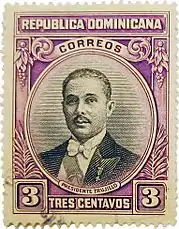
Three-and-a-half weeks after Trujillo ascended to the presidency, the destructive Hurricane San Zenon hit Santo Domingo and left 2,000 dead. As a response to the disaster, Trujillo placed the Dominican Republic under martial law and began to rebuild the city. He renamed the rebuilt capital of the Dominican Republic Ciudad Trujillo ("Trujillo City") in his honor and had streets, monuments, and landmarks to honor him throughout the country.[21]
On 16 August 1931, the first anniversary of his inauguration, Trujillo made the Dominican Party the nation's sole legal political party. However, the country had effectively become a one-party state with Trujillo's inauguration. Government employees were required by law to "donate" 10 percent of their salaries to the national treasury,[22][23] and there was strong pressure on adult citizens to join the party. Members had to carry a membership card, nicknamed the "palmita" since the cover had a palm tree on it, and a person could be arrested for vagrancy without one. Those who did not join or contribute to the party did so at their own risk. Opponents of the régime were mysteriously killed.
In 1934, Trujillo, who had promoted himself to generalissimo of the army, was up for re-election. By then, there was no organized opposition left in the country, and he was elected as the sole candidate on the ballot. In addition to the widely rigged (and regularly uncontested) elections, he instated "civic reviews", with large crowds shouting their loyalty to the government, which would in turn create more support for Trujillo.[22]
Personality cult
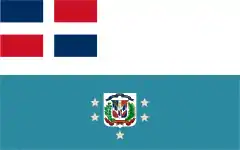
In 1936, at the suggestion of Mario Fermín Cabral, the Congress of the Dominican Republic voted overwhelmingly to change the name of the capital from Santo Domingo to Ciudad Trujillo. The province of San Cristóbal was renamed to "Trujillo" and the nation's highest peak, Pico Duarte, to Pico Trujillo. Statues of "El Jefe" were mass-produced and erected across the Dominican Republic, and bridges and public buildings were named in his honor. The nation's newspapers had praise for Trujillo as part of the front page, and license plates included slogans such as "¡Viva Trujillo!" and "Año Del Benefactor De La Patria" (Year of the Benefactor of the Nation). An electric sign was erected in Ciudad Trujillo so that "Dios y Trujillo" could be seen at night as well as in the day. Eventually, even churches were required to post the slogan "Dios en cielo, Trujillo en tierra" (God in Heaven, Trujillo on Earth). As time went on, the order of the phrases was reversed (Trujillo on Earth, God in Heaven). Trujillo was recommended for the Nobel Peace Prize by his admirers, but the committee declined the suggestion.[24]
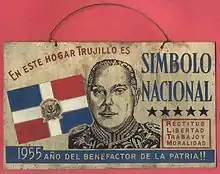
Trujillo was eligible to run again in 1938, but, citing the United States example of two presidential terms, he stated, "I voluntarily, and against the wishes of my people, refuse re-election to the high office."[25] In fact, a vigorous re-election campaign had been launched in the middle of 1937 but the international uproar that followed the Haitian massacre later that year forced Trujillo to announce his "return to private life."[26] Consequently, the Dominican Party nominated Trujillo's handpicked successor, 71-year-old vice-president Jacinto Peynado, with Manuel de Jesús Troncoso his running mate. They appeared alone on the ballot in the 1938 election. Trujillo kept his positions as generalissimo of the army and leader of the Dominican Party. It was understood that Peynado was merely a puppet, and Trujillo still held all governing power in the nation. Peynado increased the size of the electric "Dios y Trujillo" sign and died on 7 March 1940, with Troncoso serving out the rest of the term. However, in 1942, with US President Franklin Roosevelt having run for a third term in the United States, Trujillo ran for president again and was elected unopposed. He served for two terms, which he lengthened to five years each. In 1952, under pressure from the Organization of American States, he ceded the presidency to his brother, Héctor. Despite being officially out of power, Rafael Trujillo organized a major national celebration to commemorate 25 years of his rule in 1955. Gold and silver commemorative coins were minted with his image.
Oppression

Brutal oppression of actual or perceived members of the opposition was the key feature of Trujillo's rule from the very beginning in 1930 when his gang, "The 42", led by Miguel Angel Paulino, drove through the streets in their red Packard "carro de la muerte" ("car of death").[27] Trujillo also maintained an execution list of people throughout the world who he felt were his direct enemies or who he felt had wronged him. He even once allowed an opposition party to form and permitted it to operate legally and openly, mainly so that he could identify those who opposed him and arrest or kill them.[28]
Imprisonments and killings were later handled by the SIM, the Servicio de Inteligencia Militar, efficiently organized by Johnny Abbes, who operated in Cuba, Mexico, Guatemala, New York, Costa Rica, and Venezuela.[29] Some cases reached international notoriety such as the disappearance of Jesús de Galíndez and the murder of the Mirabal sisters, which further eroded Trujillo's critical support by the US government. After Trujillo approved an assassination attempt on the Venezuelan President Rómulo Ernesto Betancourt Bello, the Organization of American States and the United States blocked Trujillo's access to US sugar quota profits.[30]
Immigration
Trujillo was known for his open-door policy, accepting Jewish refugees from Europe, Japanese migration during the 1930s, and exiles from Spain following its civil war. He developed a uniquely Dominican policy of racial discrimination, Antihaitianismo ("anti-Haitianism"), targeting the mostly black inhabitants of his neighboring country and those within the Platano Curtain, including many Afro-Dominican citizens. At the 1938 Évian Conference the Dominican Republic was the only country willing to accept many Jews and offered to accept up to 100,000 refugees on generous terms.[31] In 1940 an agreement was signed and Trujillo donated 26,000 acres (110 km2) of his properties for settlements. The first settlers arrived in May 1940; eventually, some 800 settlers came to Sosua and most moved later on to the United States.[31]
Refugees from Europe broadened the Dominican Republic's tax base and added more whites to the predominantly mixed-race nation. The government favored white refugees over others while Dominican troops expelled illegal aliens, resulting in the 1937 Parsley Massacre of Haitian immigrants.
Environmental policy
The Trujillo regime greatly expanded the Vedado del Yaque, a nature reserve around the Yaque del Sur River. In 1934 he banned the slash-and-burn method of clearing land for agriculture, set up a forest warden agency to protect the park system, and banned the logging of pine trees without his permission. In the 1950s the Trujillo regime commissioned a study on the hydroelectric potential of damming the Dominican Republic's waterways. The commission concluded that only forested waterways could support hydroelectric dams, so Trujillo banned logging in potential river watersheds. After his assassination in 1961, logging resumed in the Dominican Republic. Squatters burned down the forests for agriculture, and logging companies clear-cut parks. In 1967, President Joaquín Balaguer launched military strikes against illegal logging.[23]
Trujillo encouraged foreign investment in the Dominican Republic, particularly from Americans. He gave a concession with mineral rights in the Azua Basin to Clem S. Clarke, an oilman from Shreveport, Louisiana.[32]
Foreign policy
Trujillo tended toward peaceful coexistence with the United States government. During World War II Trujillo sided with the Allies and declared war on Germany, Italy and Japan on 11 December 1941. While there was no military participation, the Dominican Republic thus became a founding member of the United Nations. Trujillo encouraged diplomatic and economic ties with the United States, but his policies often caused friction with other nations of Latin America, especially Costa Rica and Venezuela. He maintained friendly relations with Franco of Spain, Perón of Argentina, and Somoza of Nicaragua. Towards the end of his rule, his relationship with the United States deteriorated.
The extensive development of the Dominican military during World War II, a buildup that continued unabated after the war with the assistance of arms-dealing countries such as Brazil and Sweden, disturbed the Caribbean peace even as the global conflict ended. Military might, much of its surplus merchandise such as P-51 Mustang fighters and B-26 Marauder bombers, maintained Trujillo as the unassailable master of the Dominican Republic. Trujillo's war-based military complex, most notably its air capability, kept neighboring Haiti in a near-constant state of tension. The threat of being bombed by the Dominican Republic extended to Cuba, Mexico, and Venezuela, among other places, as long as Rafael Trujillo retained his capricious control until 1961.[33]
Trujillo's regime carried out racially motivated killings of thousands of Haitians and committed crimes in the United States, Cuba, Puerto Rico, Venezuela, Guatemala, Costa Rica, and Mexico.
Hull–Trujillo Treaty
Early on, Trujillo determined that Dominican financial affairs had to be put in order, and that included ending the United States's role as collector of Dominican customs—a situation that had existed since 1907 and was confirmed in a 1924 convention signed at the end of the occupation.
Negotiations started in 1936 and lasted four years. On 24 September 1940, Trujillo and the American Secretary of State Cordell Hull signed the Hull–Trujillo Treaty, whereby the United States relinquished control over the collection and application of customs revenues, and the Dominican Republic committed to deposit consolidated government revenues in a special bank account to guarantee repayment of foreign debt. The government was free to set custom duties with no restrictions.[34]
This diplomatic success gave Trujillo the occasion to launch a massive propaganda campaign that presented him as the savior of the nation. A law proclaimed that the Benefactor was also now the Restaurador de la independencia financiera de la Republica (Restorer of the Republic's financial independence).[35]
Haiti
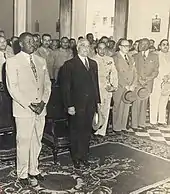
Haiti had historically occupied what is now the Dominican Republic from 1822 to 1844. Encroachment by Haiti was an ongoing process, and when Trujillo took over, specifically the northwestern border region had become increasingly "Haitianized."[36] The border was poorly defined. In 1933, and again in 1935, Trujillo met the Haitian President Sténio Vincent to settle the border issue. By 1936, they reached and signed a settlement. At the same time, Trujillo plotted against the Haitian government by linking up with General Calixte, Commander of the Garde d'Haiti, and Élie Lescot, at that time the Haitian ambassador in Ciudad Trujillo (Santo Domingo).[36] After the settlement, when further border incursions occurred, Trujillo initiated the Parsley Massacre.
Parsley Massacre
Known as La Masacre del Perejil in Spanish, the massacre was started by Trujillo in 1937. Claiming that Haiti was harboring his former Dominican opponents, he ordered an attack on the border that slaughtered tens of thousands of Haitians as they tried to escape. The number of dead is still unknown, but it is now calculated between 20,000 and 30,000.[Note 6] The Dominican military used machetes to murder and decapitate many of the victims; they also took people to the port of Montecristi, where many victims were thrown into the ocean to drown with their hands and feet bound.[38] In 1975, Joaquín Balaguer, the Dominican Republic's interim Foreign Minister at the time of the massacre, put the number of dead at 17,000.[39]
The Haitian response was muted, but its government eventually called for an international investigation. Under pressure from Washington, Trujillo agreed to a reparation settlement in January 1938 of US$750,000. By the next year, the amount had been reduced to US$525,000 (US$9.34 million in 2021); 30 dollars per victim, of which only two cents were given to survivors because of corruption in the Haitian bureaucracy.[25][40]
In 1941, Lescot, who had received financial support from Trujillo, succeeded Vincent as President of Haiti. Trujillo expected that Lescot would be his puppet, but Lescot turned against him. Trujillo unsuccessfully tried to assassinate him in a 1944 plot and then published their correspondence to discredit him.[36] Lescot fled into exile in 1946 after demonstrations against him.[41]
Cuba
In 1947 Dominican exiles, including Juan Bosch, had concentrated in Cuba. With the approval and support of Cuba's government, led by Ramón Grau, an expeditionary force was trained with the intention of invading the Dominican Republic and overthrowing Trujillo. However, international pressure, including from the United States, made the exiles abort the expedition.[42] In turn, when Fulgencio Batista was in power, Trujillo initially supported anti-Batista supporters of Carlos Prío Socarrás in Oriente Province in 1955; however, weapons Trujillo sent were soon inherited by Fidel Castro's insurgents when Prío allied with Castro. After 1956, when Trujillo saw that Castro was gaining ground, he started to support Batista with money, planes, equipment, and men. Trujillo, convinced that Batista would prevail, was very surprised when Batista showed up as a fugitive after he had been ousted. Trujillo kept Batista until August 1959 as a "virtual prisoner."[43] Only after paying US$3-4 million could Batista leave for Portugal, which had granted him a visa.[43]
Castro made threats to overthrow Trujillo, who responded by increasing the budget for national defense. A foreign legion formed to defend Haiti, as many expected that Castro might invade the Haitian part of the island first and remove François Duvalier as well. On 14 June 1959, an abortive invasion to topple Trujillo began. On that day, a plane with Dominican markings left Cuba and landed at the Cordillera Central in the Dominican Republic. On board were 225 men, led by the Dominican Enrique Jimenez Moya and the Cuban Delico Gomez Ochoa, both of whom were friends of Castro. The invasion force was composed of men from various Latin American countries and Spain. Some Americans also participated. As soon as the invaders landed, they were met by soldiers of the Dominican Army, and 30 to 40 men escaped.
A week later, another group of invaders boarded two yachts and was escorted by Cuban gunboats to Great Inagua, in the Bahamas, heading for the Dominican coast. Instead, the group was spotted by Dominican soldiers who blasted the yacht to pieces. Trujillo ordered his son, Ramfis, to lead the hunt for the invaders, and soon they were captured. The leaders of the invasion were taken aboard a Dominican Air Force plane and then pushed out in midair; they fell to their deaths.
In turn, in August 1959, Johnny Abbes attempted to support an anti-Castro group led by Escambray near Trinidad, Cuba. The attempt, however, was thwarted when Cuban troops surprised a plane that he had sent as it unloaded its cargo.[44]
Betancourt incident
By the late 1950s, opposition to Trujillo's regime was building to a fever pitch. Many clamored for democratization, particularly those of younger generations who had no memory of the poverty and instability that preceded Trujillo. The Trujillo regime responded with greater repression. The Military Intelligence Service (SIM) secret police, led by Johnny Abbes, remained as ubiquitous as before.
Trujillo began to interfere more in the domestic affairs of neighboring countries. He expressed great contempt for Venezuelan President Rómulo Betancourt. An established and outspoken opponent of Trujillo, Betancourt associated with Dominicans who had plotted against the dictator. Trujillo developed an obsessive personal hatred of Betancourt and supported numerous plots by Venezuelan exiles to overthrow him. This pattern of intervention led the Venezuelan government to take its case against Trujillo to the Organization of American States (OAS). That infuriated Trujillo, who ordered his agents to plant a bomb in Betancourt's car. On 24 June 1960, while Betancourt was driving through the streets of Caracas, Venezuela, during the annual Army Day parade, a powerful bomb exploded in his motorcade. The bomb had been placed in a green Oldsmobile parked near the parade route and contained 65 kilograms of TNT. The blast exploded right under the car carrying Betancourt and his party. The car was sent flying across the street. One person in the auto was killed, and Betancourt suffered severe burns to his hands.[45]
The Betancourt incident inflamed world opinion against Trujillo. Outraged OAS members voted unanimously to sever diplomatic relations with his government and impose economic sanctions on the Dominican Republic. The brutal murder on Friday, 25 November 1960, of the three Mirabal sisters, Patria, María Teresa and Minerva, who opposed Trujillo's dictatorship, further increased discontent with his repressive rule.
Personal life
Trujillo's "central arch" was his instinct for power.[46] This was coupled with an intense desire for money, which he recognized as a source of and support for power. Up at four in the morning, he exercised, studied the newspaper, read many reports, and completed papers before breakfast. At the office by nine, he continued his work, and took lunch by noon. After a walk, he continued to work until 7:30 pm. After dinner, he attended functions, held discussions, or was driven around incognito in the city "observing and remembering."[46] Until Santo Domingo's National Palace was built in 1947, he worked out of the Casas Reales, the colonial-era Viceregal center of administration. Today the building is a museum; on display are his desk and chair, along with a massive collection of arms and armor that he bought. He was methodical, punctual, secretive, and guarded; he had no true friends, only associates and acquaintances. For his associates, his actions towards them were unpredictable.
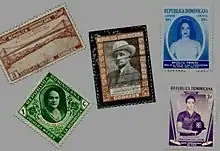
Trujillo and his family amassed enormous wealth. He acquired cattle lands on a grand scale, and went into meat and milk production, operations that soon evolved into monopolies. Salt, sugar, tobacco, lumber, and the lottery were other industries that he or his family members dominated. Family members also received positions within the government and the army, including one of Trujillo's sons who was made a colonel in the Dominican Army when he was only four years old.[Note 7][Note 8] Two of Trujillo's brothers, Héctor and José Arismendy, also held positions in his government. José Arismendy Trujillo oversaw the creation of the main radio station, La Voz Dominicana, and later the television station, the fourth in the Caribbean.
By 1937 Trujillo's annual income was about $1.5 million ($27 million in 2019);[48] at the time of his death the state took over 111 Trujillo-owned companies. His love of fine and ostentatious clothing was displayed in elaborate uniforms and suits, of which he collected almost two thousand.[49] Fond of neckties, he amassed a collection of over ten thousand. Trujillo doused himself with perfume and liked gossip.[50] His sexual appetite was rapacious, and he preferred mulatto women with full bodies, later tending to rape "very young" women.[46] Many who sought his favors procured women for him, and later, he had an official on his palace staff to organize the sessions. Encounters typically lasted for one or two sessions, but he often kept favorites for longer terms. If women resisted, Trujillo pressured their families to get his way.[46]
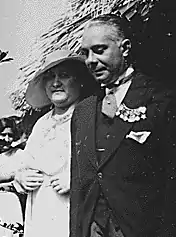
Trujillo was married three times and kept other women as mistresses. On 13 August 1913, Trujillo married Aminta Ledesma Lachapelle. On 30 March 1927, Trujillo married Bienvenida Ricardo Martínez, a girl from Monte Cristi and the daughter of Buenaventura Ricardo Heureaux. A year later he met María de los Angeles Martínez Alba "la españolita", and had an affair with her. He divorced Bienvenida in 1935 and married Martínez. A year later he had a daughter with Bienvenida, named Odette Trujillo Ricardo.
Trujillo's three children with María Martínez were Rafael Leónidas Ramfis, who was born on 5 June 1929, María de los Ángeles del Sagrado Corazón de Jesús (Angelita), born in Paris on 10 June 1939, and Leónidas Rhadamés, born on 1 December 1942. Ramfis and Rhadamés were named after characters in Giuseppe Verdi's opera Aida.
In 1937, Trujillo met Lina Lovatón Pittaluga,[51] an upper-class debutante with whom he had two children, Yolanda in 1939, and Rafael, born on 20 June 1943.
In spite of Trujillo's indifference to the game of baseball, the dictator invited many black American players to the Dominican Republic, where they received good pay for playing on first-class, un-segregated teams. The great Negro league star Satchel Paige pitched for Los Dragones of Ciudad Trujillo, a team organized by Trujillo. Paige later claimed, jokingly, that his guards positioned themselves "like a firing squad" to encourage him to pitch well. Los Dragones won the 1937 Dominican championship at Estadio Trujillo in Ciudad Trujillo.[52]
Trujillo was energetic and fit. He was generally quite healthy but suffered from chronic lower urinary infections and, later, prostate problems. In 1934, Dr. Georges Marion was called from Paris to perform three urologic procedures on Trujillo.[53]
Over time Trujillo acquired numerous homes. His favorite was Casa Caobas, on Estancia Fundacion near San Cristóbal.[54] He also used Estancia Ramfis (which, after 1953, became the Foreign Office), Estancia Rhadames, and a home at Playa de Najayo. Less frequently he stayed at places he owned in Santiago de los Caballeros, Constanza, La Cumbre, San José de las Matas, and elsewhere. He maintained a penthouse at the Embajador Hotel in the capital.[55]
While Trujillo was nominally a Roman Catholic, his devotion was limited to a perfunctory role in public affairs; he placed faith in local folk religion.[46]
He was popularly known as "El Jefe" ("The Chief") or "El Benefactor" ("The Benefactor") but was privately referred to as Chapitas ("Bottlecaps") because of his indiscriminate wearing of medals. Dominican children emulated Trujillo by constructing toy medals from bottle caps. He was also known as "El Chivo" ("The Goat").
Death
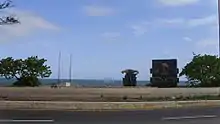
On Tuesday, 30 May 1961, Trujillo was shot and killed when his blue 1957 Chevrolet Bel Air was ambushed on a road outside the Dominican capital.[56] He was the victim of an ambush plotted by a number of men, such as General Juan Tomás Díaz, Pedro Livio Cedeño, Antonio de la Maza, Amado García Guerrero and General Antonio Imbert Barrera.[57] The plotters, however, failed to take control as the later-executed General José René Román Fernandez ("Pupo Román") betrayed his co-conspirators by his inactivity, and contingency plans had not been made.[58] On the other side, Johnny Abbes, Roberto Figueroa Carrión, and the Trujillo family put the SIM to work to hunt the members of the plot and brought back Ramfis Trujillo from Paris to step into his father's shoes. The response by the SIM was swift and brutal. Hundreds of suspects were detained, many tortured. On 18 November the last executions took place when six of the conspirators were executed in the "Hacienda María Massacre."[59] Imbert was the only one of the seven assassins who survived the manhunt.[60] A co-conspirator named Luis Amiama Tio also survived.
US President John F. Kennedy learned of Trujillo's death during a diplomatic meeting with French President Charles de Gaulle.[61]
Trujillo's funeral was that of a statesman with the long procession ending in his hometown of San Cristóbal, where his body was first buried. Dominican President Joaquín Balaguer gave the eulogy. The efforts of the Trujillo family to keep control of the country ultimately failed. The military uprising on 19 November of the Rebellion of the Pilots and the threat of American intervention set the final stage and ended the Trujillo regime.[62] Ramfis tried to flee with his father's body upon his boat Angelita, but was turned back. Balaguer allowed Ramfis to leave the country and to relocate his father's body to Paris. There, the remains were interred in the Cimetière du Père Lachaise on 14 August 1964, and six years later moved to Spain, to the Mingorrubio Cemetery in El Pardo on the north side of Madrid.[63]
The role of the CIA in the killing has been debated. Imbert insists that the plotters acted on their own.[60] However, Trujillo was certainly murdered with weapons supplied by the CIA.[64][60][65]
In a 1975 report to the Deputy Attorney General of the United States, CIA officials described the agency as having "no active part" in the assassination and only a "faint connection" with the groups that planned the killing.[66] However, the report is contradicted by later evidence.
US involvement appears to go deeper than supplying weapons. In the 1950s, the CIA gave José Figueres Ferrer money to publish a political journal, Combate and to found a left-wing school for Latin American opposition leaders.[67] Funds passed from a shell foundation to the Jacob Merrill Kaplan Fund; then to the Institute of International Labor Research (IILR) headed by Norman Thomas, six-time US presidential candidate for the Socialist Party of America; and finally to Figueres, Sacha Volman, and Juan Bosch.[68][67][65] Sacha Volman, treasurer of the IILR, was a CIA agent.[67]
Cord Meyer was a CIA official responsible for manipulating international groups.[67] He used the contacts with Bosch, Volman, and Figueres for a new purpose, as the United States moved to rally the Western Hemisphere against Cuba's Fidel Castro, Trujillo had become expendable.[67] Dissidents inside the Dominican Republic argued that assassination was the only certain way to remove Trujillo.[67]
According to Chester Bowles, the Undersecretary of State, internal Department of State discussions in 1961 on the topic were vigorous.[69] Richard N. Goodwin, Assistant Special Counsel to the President, who had direct contacts with the rebel alliance, argued for intervention against Trujillo.[69] Quoting Bowles directly: The next morning I learned that in spite of the clear decision against having the dissident group request our assistance Dick Goodwin following the meeting sent a cable to CIA people in the Dominican Republic without checking with State or CIA; indeed, with the protest of the Department of State. The cable directed the CIA people in the Dominican Republic to get this request at any cost. When Allen Dulles found this out the next morning, he withdrew the order. We later discovered it had already been carried out.[69]
An internal CIA memorandum states that a 1973 Office of Inspector General investigation into the murder disclosed "quite extensive Agency involvement with the plotters." The CIA described its role in "changing" the government of the Dominican Republic "as a 'success' in that it assisted in moving the Dominican Republic from a totalitarian dictatorship to a Western-style democracy."[70][67]
Juan Bosch, the earlier recipient of CIA funding, was elected president of the Dominican Republic in 1962 and was deposed in 1963.[68]
Even after the death of Trujillo, the unusual events continued. In November 1961, Mexican police found a corpse they identified as Luis Melchior Vidal, Jr., godson of Trujillo.[65] Vidal was the unofficial business agent of the Dominican Republic while Trujillo was in power.[65] Under the cover of the American Sucrose Company and the Paint Company of America, Vidal had teamed up with an American, Joel David Kaplan, to operate as arms merchants for the CIA.[65]
Joel David Kaplan was the nephew of the previously mentioned Jacob Merrill Kaplan.[71] The elder Kaplan earned his fortune primarily through operations in Cuba and the Dominican Republic.
In 1962, the younger Kaplan was convicted of killing Vidal, in Mexico City.[65] He was sentenced to 28 years in prison.[65] Kaplan escaped from a Mexican prison using a helicopter. The dramatic event was the basis for the Charles Bronson action film Breakout.[72][73]
The Mexican police requested for the FBI to arrest and remand Joel Kaplan on 20 August 1971.[65] Kaplan's attorney claimed that Kaplan was a CIA agent.[65] Neither the FBI nor the US Department of Justice has pursued the issue.[65] The Mexican government never initiated extradition proceedings against Kaplan.[73]
Honors and awards
In media
| Media type | Title | Release date | Details |
|---|---|---|---|
| Book | Trujillo: The Little Caesar of the Caribbean | 1958 | Authored by Germán Ornes Coiscou, this book reveals the terror of Trujillo's dictatorship as it became a cancerous growth infecting generations of Dominicans for more than 30 years. |
| Book | In the Time of the Butterflies | 1994 | Authored by Julia Alvarez, the book describes the lives of the four Mirabal Sisters, who lived under Trujillo's regime; three of them eventually were killed after joining the resistance against his rule. |
| Book | The Terrible Ones | 1966 | Authored by Valerie Moolman, the book describes the attempts of The Terrible Ones (the widows of murdered Trujillo opponents), Cuban fidelistas and Chinese communist forces to locate and recover US$100 million in gold and precious stones accumulated by Trujillo during his dictatorship. |
| Book | The Day of the Jackal | 1971 | Authored by Frederick Forsyth, the book fictitiously attributes "credit" for this assassination to the titular assassin. An English arms dealer, suspected of being "the Jackal", had a meeting with Trujillo's chief of police in Ciudad Trujillo on 30 May 1961, trying to sell the police British surplus submachine guns. However, Trujillo is assassinated that same day, and the arms dealer is forced to flee the Dominican Republic. |
| Film | The Day of the Jackal | 1973 | Directed by Fred Zinnemann, the film, like the book of the same title, fictitiously attributes "credit" for this assassination to its titular assassin. |
| Book | Memorias de un Cortesano de la Era de Trujillo | 1988 | Authored by Joaquín Balaguer, the last puppet president of the Dominican Republic appointed by Trujillo, in 1960, and who went on to rule in his own right for most of the period 1966–1996. |
| Book | La era de Trujillo: un estudio casuístico de dictadura hispanoamericana | 1990 | Manuel Vazquez Montalbán, a Catalan writer, wrote about Galíndez en 1990. The book is a fictional recreation of the life and disappearance of the diplomat. |
| Documentary | El Poder del Jefe I | 1994 | Directed by René Fortunato |
| Documentary | Ken Burns' Baseball | 1994 | Winning the Dominican National Championship with Satchel Paige and Josh Gibson discussed in Inning Five: Shadow Ball. |
| TV Film | Soul of the Game | 1996 | Brief appearance during a baseball game in Santo Domingo. |
| Documentary | El Poder del Jefe II | 1996 | Directed by René Fortunato |
| Documentary | El Poder del Jefe III | 1998 | Directed by René Fortunato |
| Book | The Feast of the Goat | 2000 | A book by Mario Vargas Llosa, set in the Dominican Republic and portraying the assassination of the Dominican dictator, and its aftermath, from two distinct standpoints a generation apart: during and immediately after the assassination itself, in May 1961; and thirty-five years later, in 1996. |
| TV Film | In the Time of the Butterflies | 2001 | Directed by Mariano Barroso and Trujillo played by Edward James Olmos. Based on the novel by Julia Alvarez (1994) about the regime assassination of the dissident Mirabal sisters. |
| Book | Before We Were Free | 2002[76] | Julia Alvarez, a Dominican-American writer, wrote this young-adult novel about Anita, a twelve-year-old girl in the Dominican Republic in 1960, who realizes that life under the reign of Trujillo is much darker and more dangerous than she had previously known. |
| Film | El Misterio Galíndez - The Galindez File | 2003 | Gerardo Herrero directed El Misterio Galíndez, a movie about Jesús de Galíndez Suárez, activist of the PNV party and Basque diplomat who disappeared in 1956; allegedly because of his opposition to Trujillo's regime. |
| Film | The Feast of the Goat (*) | 2006 | Directed by Luis Llosa and Trujillo played by Tomás Milián |
| Book | The Brief Wondrous Life of Oscar Wao | 2007 | Written by Junot Díaz, a Santo Domingo-born American, wrote this Pulitzer Prize–winning book about a Dominican-American family. The book is a fictional account of the family's misfortunes interwoven with a recounting of the atrocities of Trujillo's regime, some of which are indirectly linked to the family's fate, following them like a curse or fukú across the generations. |
| Film | Code Name: Butterflies | 2009 | Directed by Cecilia Domeyko Film about the life and death of the Mirabal sisters with interviews with people involved, and recreations of key events. |
| Film | Trópico de Sangre | 2010 | Directed by Juan Delancer and Trujillo played by Juan Fernández de Alarcon. The film focuses on Minerva Mirabal and tells the true story of how she and her sisters dared to stand up against dictator Rafael Trujillo and were assassinated in 1960 as a result. The film further details how this crime led to the assassination of Trujillo. |
See also
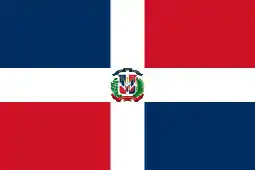 Dominican Republic portal
Dominican Republic portal Biography portal
Biography portal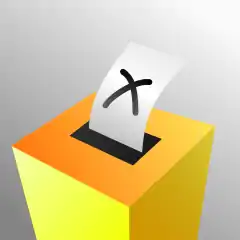 Politics portal
Politics portal
Explanatory notes
- Rafael Estrella from 3 March 1930 to 16 August 1930; Jacinto Peynado from 16 August 1938 to 7 March 1940; Manuel Troncoso from 7 March 1940 to 18 May 1942; Héctor Trujillo from 16 August 1952 to 3 August 1960; Joaquín Balaguer from 3 August 1960 until 16 January 1962, 8 months after Trujillo's death
- Crassweller mentions those estimates and adds that, "A figure of 15,000 to 20,000 would be reasonable, but this is guesswork."[4]
- Roorda mentions 12,000 as a likely figure.[5]
- Jésus de Galindez points out in the introduction of his book La Era de Trujillo that "In this summer of 1955, half the Latin American republics are ruled by dictatorships, most of them of the military type".[8]
- His siblings were Virgilio Trujillo (24 July 1887 – 29 July 1967), Flérida Marina Trujillo (10 August 1888 – 13 February 1976), Rosa María Julieta Trujillo (5 April 1893 – 23 October 1980), José Arismendy "Petán" Trujillo (4 October 1895 – 6 May 1969), Amable Romero "Pipi" Trujillo (14 August 1896 – 19 September 1970), Luisa Nieves Trujillo (4 August 1899 – 25 January 1977), Julio Aníbal "Bonsito" Trujillo (16 October 1900 – 2 December 1948), Pedro Vetilio "Pedrito" Trujillo (27 January 1902 – 14 March 1981), Ofelia Japonesa Trujillo (26 May 1905 – 4 February 1978) and Héctor Bienvenido "Negro" Trujillo (6 April 1908 – 19 October 2002).
- "anyone of African descent found incapable of pronouncing correctly, that is, to the complete satisfaction of the sadistic examiners, became a condemned individual. This killing is recorded as having a death toll reaching thirty thousand innocent souls, Haitians as well as Dominicans."[37]
- Decree of 18 April 1933.[47]
- In 1935, Ramfis, then aged 6, was promoted to general.
References
Citations
- Espinal Hernández, Edwin Rafael (21 February 2009). "Descendencias Presidenciales: Trujillo" (in Spanish). Instituto Dominicano de Genealogía. Archived from the original on 2 May 2014. Retrieved 15 April 2015.
- "I shot the cruellest dictator in the Americas". BBC News. 2011. Retrieved 19 June 2013.
- Capdevilla (1998)
- Crassweller (1966), p. 156
- Eric Paul Roorda (1996). "Genocide next door: the Good Neighbor policy, the Trujillo regime, and the Haitian massacre of 1937". Diplomatic History. 20 (3): 301–319. doi:10.1111/j.1467-7709.1996.tb00269.x.
- Rogozinski 258
- "Documentary Heritage on the Resistance and Struggle for Human Rights in the Dominican Republic, 1930-1961" (PDF).
- de Galindez (1962), p. 15
- Capdevilla (1998), p. 10
- Rafael Trujillo. [Internet]. 2015. The History Channel website. Available from: http://www.history.com/topics/rafael-trujillo [Accessed 14 May 2015].
- Antonio José Ignacio Guerra Sánchez (12 April 2008). "Trujillo: Descendiente de la Oligarquía Haitiana (1 de 2)". Santo Domingo: Instituto Dominicano de Genealogía. Archived from the original on 21 March 2014. Retrieved 1 May 2014.
- Antonio José Ignacio Guerra Sánchez (24 April 2008). Instituto Dominicano de Genealogía (ed.). "Trujillo, descendiente de oligarquía haitiana (2 de 2)". Cápsulas Genealógicas. Hoy. Archived from the original on 1 May 2014. Retrieved 1 May 2014.
- Eric Roorda (1998). The Dictator Next Door: The Good Neighbor Policy and the Trujillo Regime in the Dominican Republic, 1930–1945. Duke University Press. p. 48. ISBN 9780822321231.
- Diederich (1978), p. 13
- Oboler, Suzanne; González, Deena J, eds. (2005). The Oxford Encyclopedia of Latinos and Latinas in the United States. Oxford University Press. doi:10.1093/acref/9780195156003.001.0001. ISBN 9780195156003.
- "Golpe de Estado a Horacio Vásquez" (in Spanish). Santo Domingo: Museo Memorial de la Resistencia Dominicana. 2010. Retrieved 8 June 2013.
- Torres, José Antonio (20 February 2010). "Golpe de Estado a Horacio". El Nacional (in Spanish). Archived from the original on 27 September 2013. Retrieved 8 June 2013.
- de Galindez (1962), p. 44
- Official results: 223,731 vs 1,883. de Galindez, p. 51
- de Galindez, p. 51, note 2.
- http://www.history.com/topics/rafael-trujillo
- Block (1941), pp. 870–872
- Diamond (2005)
- Roorda, Eric (1998). The Dictator Next Door. Duke University Press. p. 120. ISBN 9780822321231.
- Block (1941), p. 672
- de Galindez (1962), p. 306
- Crassweller (1966), p. 71
- Spindel, Bernard (1968). The Ominous Ear. Award House. pp. 74–104.
- Fradinger, Moira (2010). Binding Violence: Literary Visions of Political Origins. Stanford University Press. p. 214.
- Leonard, Thomas M. (2017). "Latin American history and culture: Encyclopedia of modern Latin America (1900 to the present)". Retrieved 18 November 2019. Cite journal requires
|journal=(help) - Crassweller (1966), pp. 199–200
- Historians Allan Nevins and Frank Ernest Hill. Reminiscences of Clem S. Clarke: Oral history, 1951. New York City: Columbia University. OCLC 122308295.
- Latin America During World War II. p. 90.
- Capdevilla (1998), p. 84
- Capdevilla (1998), p. 85
- Crassweller (1966), pp. 149–163
- Alan Cambeira (1997). Quisqueya la bella (October 1996 ed.). M. E. Sharpe. p. 182. ISBN 978-1-56324-936-5.
- Galván, Javier A. (2012). Latin American Dictators of the 20th Century: The Lives and Regimes of 15 Rulers. McFarland. p. 53.
- Wucker, Michele (8 April 2014). Why the Cocks Fight: Dominicans, Haitians, and the Struggle for Hispaniola. ISBN 9781466867888.
- Bell, Madison Smartt (2008). "A Hidden Haitian World". New York Review of Books. 55 (12): 41.
- Matthew J. Smith (December 2004). "VIVE 1804!: The Haitian Revolution and the Revolutionary Generation of 1946". Caribbean Quarterly. Taylor & Francis, Ltd. 50 (4): 25–41. doi:10.1080/00086495.2004.11672248. JSTOR 40654477. S2CID 151106144.
- Crassweller (1966), pp. 237ff
- Crassweller (1966), pp. 344–348
- Crassweller (1966), p. 351
- Trinkunas, Harold A. (20 January 2011). Crafting Civilian Control of the Military in Venezuela: A Comparative Perspective. ISBN 9780807877036.
- Crassweller (1966), pp. 73–95
- de Galindez (1962), p. 62
- Federal Reserve Bank of Minneapolis. "Consumer Price Index (estimate) 1800–". Retrieved 1 January 2020.
- Crassweller (1966), p. 73
- "Reach Information Portal". Healthcare.reachinformation.com. 24 March 2009. Archived from the original on 3 December 2013. Retrieved 2 October 2012.
- Derby, Lauren H. (2000). "The Dictator's seduction: gender and state spectacle during the Trujillo regime". Callaloo. 23 (3): 1112–1146. doi:10.1353/cal.2000.0134. S2CID 162243104.
- Callard, Abby;Remembering Legendary Pitcher Satchel Paige, 2009, Smithsonian.com; http://www.smithsonianmag.com/smithsonian-institution/remembering-legendary-pitcher-satchel-paige-16345711/?no-ist retvd 7 19 15
- Crassweller (1966), p. 115
- Crassweller (1966), p. 144
- Crassweller (1966), p. 270
- Harris, Bruce. "Moreorless: Heroes & Killers of the 20th century". Archived from the original on 15 November 2011. Retrieved 12 November 2011.
- Museo Memorial de la Resistencia Dominicana. "Heroes del 30 de Mayo. Resenas Biograficas" (in Spanish). Retrieved 16 August 2012.
- Diederich (1978), pp. 150f
- Diederich (1978), pp. 235ff
- BBC (27 May 2011). "I shot the cruellest dictator in the Americas". Retrieved 16 August 2012.
- "Meeting with President de Gaulle in France - John F. Kennedy". Archived from the original on 24 February 2015.CS1 maint: bot: original URL status unknown (link)
- Diederich (1978), pp. 250f
- Castellanos, Eddy (11 April 2008). "Solitaria, en cementerio poco importante, está la tumba de Trujillo" (in Spanish). Almomento.net. Archived from the original on 2 April 2012. Retrieved 14 November 2011.
- Kross, Peter (9 December 2018). "The Assassination of Rafael Trujillo". Sovereign Media. Retrieved 17 January 2019.
- "The Kaplans of the CIA - Approved For Release 2001/03/06 CIA-RDP84-00499R001000100003-2" (PDF). Central Intelligence Agency. 24 November 1972. pp. 3–6. Retrieved 17 January 2019.
- Justice Department Memo, 1975; National Security Archive
- Ameringer, Charles D. (1 January 1990). U.S. Foreign Intelligence: The Secret Side of American history (1990 ed.). Lexington Books. ISBN 978-0669217803.
- Iber, Patrick (24 April 2013). ""Who Will Impose Democracy?": Sacha Volman and the Contradictions of CIA Support for the Anticommunist Left in Latin America". Diplomatic History. Retrieved 17 January 2019.
- Bowles, Chester (3 June 1961). "FOREIGN RELATIONS OF THE UNITED STATES, 1961–1963, VOLUME XII, AMERICAN REPUBLICS 310. Memorandum by the Under Secretary of State (Bowles) NOTES ON CRISIS INVOLVING THE DOMINICAN REPUBLIC". United States Department of State.
- CIA "Family Jewels" Memo, 1973 (see page 434) Family Jewels (Central Intelligence Agency)
- "Whirlaway". TIME. 30 August 1971. Retrieved 2 May 2009.
- Constatine, Alex The CIA, the JM Kaplan Fund & a 1971 Prison Breakout in Mexico 16 March 2010
- Rothman, Lily (8 June 2015). "The Strange Case of the Non-Criminal Jail Break". TIME. Retrieved 17 January 2019.
- Time, 1939
- Order of the Holy Sepulchre of Jerusalem
- Julia Alvarez (2002). Before We Were Free. A. Knopf. ISBN 978-0-375-81544-7.
General bibliography
- Block, Maxine (1941). E. Mary Trow (ed.). Current Biography Who's News and Why. The H. W. Wilson Company. ISBN 978-9997376671.
- Capdevilla, Lauro (1998). La dictature de Trujillo, République dominicaine, 1930–1961. Paris, Montreal: L'Harmattan.
- Crassweller, Robert D. (1966). The Life and Times of a Caribbean Dictator. New York: The Macmillan Company.
- de Galindez, Jésus (1962) [1956]. L'Ère de Trujillo. Paris: Gallimard.
- Diamond, Jared (2005). Collapse: How Societies Choose to Fail or Succeed. Penguin (Non-Classics). ISBN 978-0-14-303655-5.
- Diederich, Bernard (1978). Trujillo, The Death of the Goat. Little, Brown, and Co. ISBN 978-0-316-18440-3.
- Pack, Robert; Parini, Jay (1997). Introspections. University Press of New England. ISBN 978-0-87451-773-6.
Further reading
- Atkins, G. Pope; Larman C. Wilson (1 January 1998). The Dominican Republic and the United States: From Imperialism to Transnationalism (January 1998 ed.). University of Georgia Press. ISBN 978-0-8203-1931-5.
- Hougan, Jim, Spooks: The Haunting of America: the private use of secret agents, 1978, ISBN 9780688033552.
- López-Calvo, Ignacio, "God and Trujillo": Literary and Cultural Representations of the Dominican Dictator, University Press of Florida, 2005, ISBN 0-8130-2823-X
- "GENERALISIMO E.N., RAFAEL LEONIDAS TRUJILLO MOLINA (9). Secretario de Estado de las Fuerzas Armadas. (in Spanish)
- Timoneda, Joan C. 2020. "Institutions as Signals: How Dictators Consolidate Power in Times of Crisis". Comparative Politics 53(1): pp. 49–68.
- Turits, Richard Lee, Foundations of Despotism: Peasants, the Trujillo Regime, and Modernity in Dominican History, Stanford University Press 2004, ISBN 0-8047-5105-6
External links
| Wikimedia Commons has media related to Rafael Leónidas Trujillo. |
- Works by or about Rafael Trujillo at Internet Archive
- Biography (in Spanish)
- The short film Interview with General Rafael Trujillo (1961) is available for free download at the Internet Archive
| Political offices | ||
|---|---|---|
| Preceded by Rafael Estrella (acting) |
President of the Dominican Republic 1930–1938 |
Succeeded by Jacinto Bienvenido Peynado |
| Preceded by Manuel de Jesús Troncoso de la Concha |
President of the Dominican Republic 1942–1952 |
Succeeded by Héctor Trujillo |
